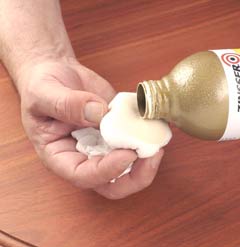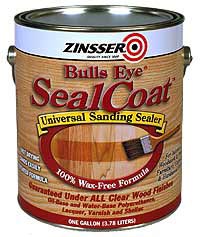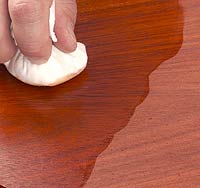
Shellac is a finish with a long and lustrous history and, right now, it is going through a renaissance of improvements. Much of the credit for that can be placed squarely at the feet of one dedicated shellac zealot. His official title is “Brand Manager of Clear Finishes,” but around the office at Zinsser, Gene Hoyas is called “The Sultan of Shellac.”
There’s good reason for that. It is hard to imagine anyone more thoroughly devoted to both delivering and improving the shellac-based finishes we woodworkers cherish. In the past few years alone, Gene guided the introduction of two products that, in my mind, are absolutely indispensable on any woodworker’s shelf. One is SealCoat, which quickly became the darling of the finishing set; the other, a unique foolproof French Polish formula, is poised to do the same.
Of course, shellac is nothing new for this venerable company. Zinsser was founded in 1849 by German émigré William Zinsser, who was the first person to introduce bleached shellac to the United States. He settled in New York and started producing small amounts to sell to fellow immigrants, mostly woodworkers and floor finishers. Soon, other tradesmen noticed the light-colored shellac, and the business grew. Their product line expanded to varnishes, paints and even hardware.
Over the years, shellac became more popular for coating food, candy, vitamins and drugs. These days, some 90% of all shellac imported is used by the food and pharmaceutical industry. Shellac as a finish became a shrinking niche market.
By the 1980’s, the company, on the verge of extinction, was bought by RPM, which resulted in a wave of aggressive expansion. At that time, their two main products were clear shellac and B-I-N, a wide spectrum, shellac-based white primer introduced just after World War II. Originally called “Bulls-I-Namel,” a word play based on the company’s Bulls Eye trademark, B-I-N has long been the favorite indoor primer of professional painters.
As other primer products emerged, like the waterbased 1-2-3 and oil-based Cover Stain, clear shellac fell out of favor. Ironically, recent VOC restrictions imposed by the EPA helped renew interest in shellac by forcing some popular lacquers and varnishes out of the market. Today, Zinsser numbers about 200 employees and makes over 100 different products. They are the only company in the United States selling pre-mixed shellac, both with and without wax.

As a finish, shellac boasts top-notch credentials. It brings out the beauty of wood, is easy to apply by brush, sponge, rag, spray gun, or even paper towel, dries very fast, making runs and sags unlikely, and is easy to sand, repair and remove. Shellac is a natural, biodegradable, renewable resource product made by bugs. The dried film is not only nontoxic, it is edible. Its primary solvent is mild-mannered ethanol, the grain alcohol that shows up in beer, wine and more strident spirits. Applicators can be cleaned up either with alcohol or with ammonia and water.
Savvy finishers have long used shellac as a sealer. It locks in virtually every contaminant common to wood including wax, grease, dirt, silicone and oils, and it is compatible both over and under every stain and finish woodworkers typically use. As luck would have it, it also blocks odors of smelly woods, mildew and even cat urine. For that reason alone, it enjoys great popularity as a floor sealer.
As it comes from nature, shellac contains about 4 percent wax. However, polyurethanes react badly to wax, which is why dewaxed shellac was coveted as a sealer. However, no one offered a pre-mixed liquid dewaxed shellac sealer; you had to mix your own from flakes. Part of the problem was that shellac has a notoriously short shelf life, especially when reduced thin enough for convenient use.
SealCoat Universal Sealer, a two pound cut, ready-to-use, dewaxed shellac, changed all that. Based on a newly patented process that gives it a far longer shelf life than what we mix ourselves, SealCoat has made mixing shellac flakes unnecessary. Before long, finishers realized it was a boon as a complete finish, and it became their favorite topcoat as well.

As SealCoat was gaining converts, Gene went to work on French Polish, their latest offering. French polishing, which became popular in the mid-nineteenth century as a technique for applying shellac via pad, has long been the holy grail of finishers. Using plain shellac, it is a fairly difficult process, so over the years, it became more talked about than practiced.
While poring through the Zinsser archives, Hoyas came across a method of French polishing in which the pad was dipped in both turpentine and shellac in succession. Mixing the two materials in liquid form worked also, he found, and it made the process easier. However, the turpentine became part of the finish, and tended to make the surface smell for months. Mineral spirits also worked as a lubricant, but it separated in the jar. Eventually, the Zinsser lab found a material that lubricates, but evaporates quickly, and Zinsser’s foolproof French Polish was born.
In 2004, Zinsser introduced their unique French Polish, a formula so mistake-proof that it instantly made the hitherto mystical practice accessible to everyone. Theirs is the only pure shellac French polish on the market made from dewaxed, decolorized, non-bleached, long shelf life shellac. Hence, it is clear and not cloudy, has outstanding resistance to water marks, and has a shelf life of at least three years. Gene says that you can prolong the shelf life even more by storing it in the refrigerator.
In the short time it has been available, Zinsser French Polish has allowed legions of the previously “French polish challenged” to master that elusive beauty of the coatings world. Lately, turners have also discovered that it is the quickest, easiest way to bring up a deep, glossy finish to wood spinning on the lathe. I guess that makes it not just superb, but downright “revolutionary.”





